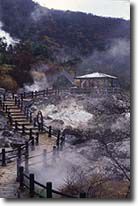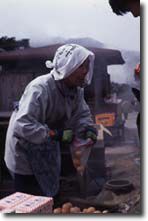|
| TRIP OUT TOP | |
||
 |
Shimabara Peninsula is a boat-ride of 40 minutes from Omuta-shi, in the southern part of Fukuoka Prefecture, Kyushu which faces the Ariake Sea. It is part of the Unzen-Amakusa National Park and picturesque in an almost tropical way. Unzendake is located in the center of the peninsula and is a group of active composite volcanoes. In May 1991, there was an eruption at Fugendake, the group's highest peak at 1,359 meters. A group of seismologists ill-advisedly went to examine the volcano too early, and all perished. But although much restoration work has resulted in new buildings and roads, you can still see houses which remain partially buried due to a rise in ground level at the time of the eruption. The lava dome is now a major tourist attraction. | |
|
The miyamakirishima, or wild Kirishima azaleas, color the slopes and there are plenty of good hot springs around. In Jigokudani (Hell Valley), you can see a monument erected to the Christian martyrs who were forced to denounce their faith in the Edo Era by standing on a picture of Jesus Christ. Those who were unable to pretend -- and later recant -- were killed. In places where the springs bubble and steam with activity, you can buy eggs boiled in the hot springs. Despite the sulfuric smell, this makes for an interesting snack, but beware of stepping away from the beaten track in the parks, since as the tourist association warns us -- "Jigoku-nai wa kiken desu." It is dangerous in hell. The Omuta area used to be named Miike, and from the late 15th century was well known for its main industry of coal mining. Like coal-mining communities the world over, the dangerous work available to most people in this area created strong communal bonds. These were to serve them well after 1873, when the Meiji government nationalized the mines and 16 years later sold them to form Mitsui Company and Mitsui Mining Co., Ltd. There were several strikes at the Miike mines after World War II, culminating in 1960 in Miike Sogi Strike, Japan's most protracted labor dispute and a testament to the strong spirit of the community. In spring 1959, Mitsui demanded the euphemistic "voluntary" retirement of 6,000 miners when it rationalized the company as demand for coal declined in favor of cheap imported oil. The union rejected this proposal, but in December 1959, Mitsui issued a list of workers to be dismissed, including many union activists. In January 1960, management declared a lockout, and the union responded with a full strike. Some 4,000 miners formed a new union, allegedly in collusion with management. Picket lines were set up, and this resulted in a battle in which one person was killed and 1,750 people were injured. In August 1960, the Central Labor Relations Commission proposed a settlement. Mitsui reduced the number of dismissals, promised extra compensation for voluntary retirement, and training for new jobs. After 282 days on strike, this was agreed to. Omuta has become depopulated in the post-war era, and is now home to around 150,000.
|
||

|
The
story of this area rich in social history is displayed at Omuta Coal Industry
and Science Museum, but coverage of the strike is not prominent, as is
often the case in Japan with "upsetting" history. You can go below ground
on an elevator that takes you several hundred meters down to watch the
huge machines at work. Another Omuta feature is playing cards, which were
introduced to Japan by Portuguese people in Miike at the end of the 16th
century. Miike Playing Card Memorial Museum features many antique cards
which are beautifully decorated. The word karuta, or playing cards, is
of Portuguese origin. In the Ogura Hyakunin Isshu game, you match 100
famous poems with the 100 authors. This originated during the Edo Era,
and is still played, especially during the New Year holidays. There are
sets of 10 famous poems available for beginners, but there are few to
match the beauty of these early cross-cultural ambassadors. |
|
